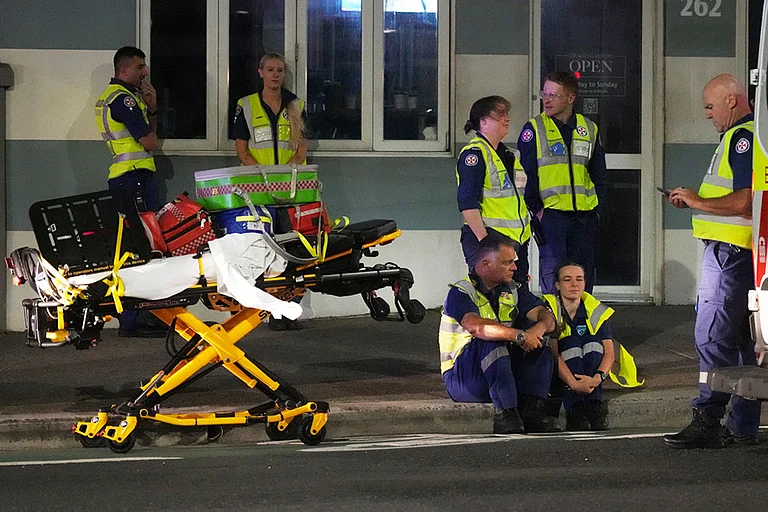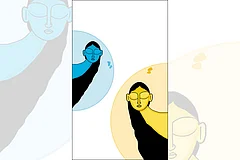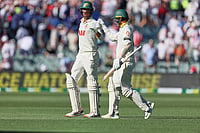For 30-year-old Anindya Avvayyam Rattan, attending family weddings always entailed questions and jibes about her “dull skin”, recommendations for homemade “fairness” packs and general tips and tricks to procure a husband “before you get too old”. So, when her big day finally came in December last year, Anindya was expectedly overwhelmed.
“I didn’t want to look ‘dull’ or ‘old’ on my wedding. I went down a spiral of self-hate with crash diets and beauty treatments,” she recalls. “It was actually my mother and aunts who insisted that I get some skin treatments done.”
After nearly a year of consultations with dermatologists, aestheticians, dieticians and beauty experts, Anindya decided to get glutathione IV drip treatment, one of the many new ‘wonder treatments’.
“They told me it would give my skin a glow from within and repair cell damage,” Anindya says. After just one session, however, she realised it was a “glorified skin whitening treatment”. “My life had turned into an episode from the fictional OTT drama Made in Heaven. I instantly opted out,” Anindya laughs.
The pressure on women to look beautiful and young is tremendous. Billboards everywhere ask women to “Reduce signs of ageing” and “Regain your youth”. Advertisements for myriad skin clinics, plastic surgery, aesthetic and wellness centres promise to turn back time. Cosmetics guarantee youth and ‘flawlessness’. Almost all such ads feature and target women.
The message is loud and clear: ageing is a disaster that affects women far more than men. Wake up and panic, ladies. Or else, fade away into old age and oblivion.
Halting Time’s March
Plastic surgeons harness state-of-the-art technology (including lasers and AI) to help women fight ageing. Wrinkles, crow’s feet, age spots, fine lines, fat, sagging skin, droopy body parts, or prominent veins—all “signs of ageing” can be tackled for a price. The range of treatments available is mind-boggling. There is face correction (nose and lip jobs), body contouring, tucks and lifts, liposuction, cool sculpting, anti-ageing treatments like chemical peels, Botox and fillers, skin whitening, and micro-braiding. There are exotic options like vampire facial, bee venom facial, photo facial, plasma facial, caviar facial, and bird poo facial.
Also on offer are shelves and shelves of supplements, powders, pills, OTC collagen, and creams containing ingredients such as retinol, hyaluronic acid and glutathione that call themselves ‘elixirs’ guaranteed to maintain or restore the appearance of youth.
“Hydrafacial, Jet Peel treatment, laser resurfacing, and IV drip therapy are some of today’s ‘in vogue’ treatments,” says Anupa Sahu, an influencer and beauty vlogger with over 50,000 followers on Instagram.
Sahu regularly posts content regarding beauty brands, procedures and make-up looks and even tries out some of these procedures for her followers.
“Cosmetic procedures work faster and are more effective than beauty products,” she says. “I have tried under-eye fillers and some other cosmetic treatments. It’s a personal choice and there’s nothing wrong with wanting to look good.”
In the last decade, the beauty industry has seen not just an explosion of products and treatments but also a demographic shift in terms of the customers. Earlier it was only women of a certain age who sought anti-ageing. “These days, some people believe in ‘pro-ageing’ instead of ‘anti-ageing’. So, instead of treatments like Botox, face shaping or collagen injections that reverse ageing, they get Hydrafacial or small feature enhancements like face-lifting fillers or laser treatments,” Sahu explains.
Some doctors like Chandigarh-based K M Kapoor, head cosmetic surgeon at the Antilock Clinic and Medispa, are fashioning treatments based on people’s “emotional attributes”.
“Some people have a typically ‘sad face’ or an ‘angry face’ due to frown lines or other signs of specific ageing. These negative emotions show up on people’s faces often due to age or stress. So when younger people come in, we try to enhance their positive attributes while in older patients, we reduce their negative emotional attributes,” Kapoor explains.
Academic Nivedita Menon, author of Seeing Like a Feminist, points out how older women in India today are not allowed the freedom of relaxing into how they look. “Earlier, as women aged, they were given ‘senior’ status and that gave them a certain standing. It was highly patriarchal then too and their gender placed them lower in the pecking order, but the pressure to look perfect as you aged was less,” says Menon.
The beauty industry nevertheless calls this tirade against ageing “empowerment”. The fact that women today can afford such treatments reflects an increase in income and spending power of women. Independent women are choosing to delay marriage or childbirth. This has also led to an increase in demand for anti-ageing treatments, some dermatologists say.
“Many of our patients are middle-aged parents who feel embarrassed to go to their child’s school meetings because they look older than other parents,” says cosmetologist Dr Puneet Kapoor. “Many women have acne scars, pigmentation, or weight issues that cause problems in their jobs.”
But where does one draw the line? Dr V K Tiwari, who practises reconstructive and plastic surgery at Vardhman Mahavir Medical College & Safdarjung Hospital, Delhi, says that as a plastic or aesthetic surgeon, it is the doctor’s responsibility to assess if the patient really needs the surgery. “Some people want unnecessary procedures because of unrealistic beauty standards. Others have psychological issues. They don’t like how they look and keep getting repeated procedures,” he says.
Extreme distress about perceived physical flaws can lead to a clinical condition called Body Dysmorphic Disorder (BDD), Professor Anirudh Kala, founding president of the Indian Association of Private Psychiatry, explains. In India, women who suffer from BDD outnumber men.
“What is beautiful and ugly are conditioned by culture and families, and the parameters are rigid and stereotypical,” says Kala. “These standards exact an enormous cost from many young girls and women, keeping them chasing after conventional ideals of physical beauty.”
“Earlier, as women aged, they were given ‘senior’ status. It was highly patriarchal then too, and their gender placed them lower in the pecking order, but the pressure to look perfect as you aged was less.”
Marketing the Dream
But who creates these ideals? The beauty journey of the Indian woman in the last two decades has been a story of branding according to beauty marketing and innovation expert Ankita Srivastava.
The way beauty is perceived is heavily influenced by brands and marketing. From a repertoire of functional usage products like talcum powder, cold cream, basic fairness creams , kajal and lipstick, the Indian cosmetics market saw a boom in choices, first in the 1990s and then again in the mid-2000s when international brands came in. “These brands created new categories to match the evolving lifestyle and aspirations of the woman, as she started redefining her role in the society. This propelled the beauty industry into a different orbit with the consumer adopting multiple cateogories – sunscreen, srubs, conditioners ,anti-ageing. Olay was one of the first to change the conversation from anti-ageing to ‘pro-ageing’ bringing into its fold much younger audiences, says Srivastava.
This growth, nevertheless, is at the cost of women’s insecurities. A popular shampoo ad from a few years ago, for instance, began with a mother dropping her daughter off at school in her car (indicating a progressive woman). Later, the daughter comes home crying, saying she wants longer hair, but hasn’t been able to grow it because the mother is a working woman and is unable to give her time. Then the shampoo is touted as the answer, telling the mother not to worry and to use it for her daughter’s hair health. The idea was to drive up the guilt of working moms. It isn’t just good hair that the ad was selling, it was also the ideal mother.
Is it the most ethical way of advertising? No. But is it done? “Yes, a lot of times. Brands need to place the product in context of how it can make life better for the consumer. Dialling up anxiety was an easy route to get the consumer to urgently act. At the same time other brands focused on rational product delivery through “active ingredients” and “working action” all in the service of guiding the consumer why she needed the new product or category.”
Outlook spoke to multiple women who nevertheless reported being pushed unnecessary products or beauty treatments by their dermatologists or parlour didis. Thirty-year-old banker Shachi Vaish says that all her life, relatives, beauticians and dermatologists have suggested she get skin-lightening treatments, hair removal, and weight loss plans because she looked ‘‘too old for her age’’.
Cosmetic treatments are costly. Microblading eyebrows can cost Rs 40,000. In high-end clinics, basic treatments like hair removal or Botox for one facial area cost about Rs 10,000 per session. Other advanced processes like Ultherapy for skin tightening, or cool sculpting for targeted weight loss can cost up to Rs 2-3 lakh. Many clinics offer cheaper alternatives but may lead to disastrous or even fatal fallouts if they are not performed by certified professionals under proper medical supervision. “We get at least one or two patients every week who come to us for corrective procedures after a botched-up beauty treatment from some clinic,” says Dr K M Kapoor.
Following a slew of complaints from consumers over the years, the Union Government set up sub-committees in 2023 to define mandatory minimum standards for skin, hair, and cosmetology clinics in the country. However, a centralised database or online platform, which the public can access to check the credentials of practising cosmetologists and plastic surgeons, is yet to be set up. And beauty continues to remain a risky business for women.
MORE FROM THIS ISSUE
(This appeared in print as ‘She’s Got The Look’)

































